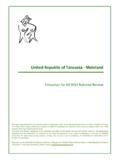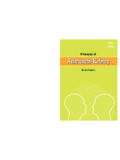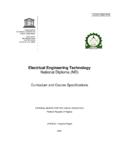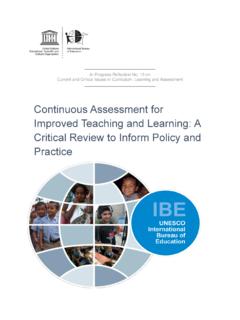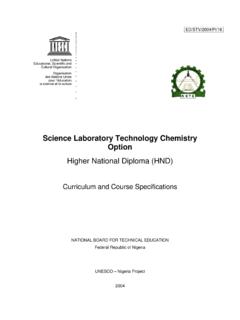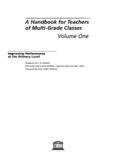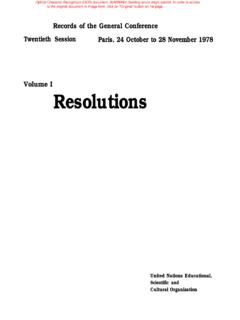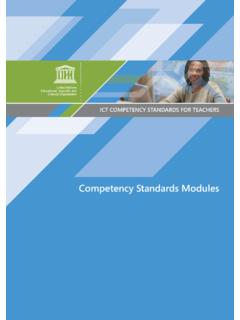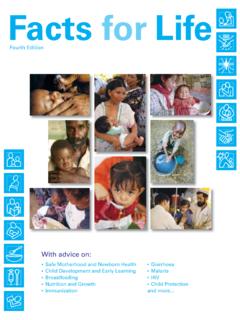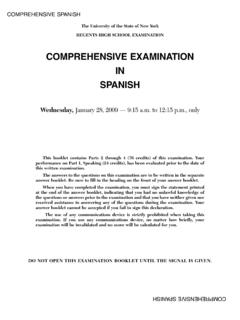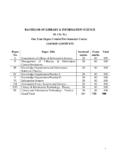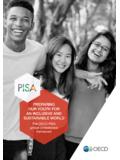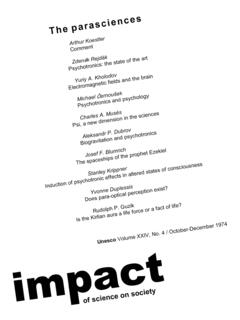Transcription of A PLANNING GUIDE - UNESCO
1 A PLANNING GUIDEINFORMATION AND COMMUNICATIONTECHNOLOGIES IN TEACHER EDUCATIONUNESCOCo-ordinator: Evgueni KhvilonEditorial co-ordinator:Mariana PatruChair and Editor:Paul Resta, The University of Texas at Austin (USA)Co-Chair:Alexey Semenov, Moscow Institute of Open Education (Russia)Other Contributors:Nancy Allen, Texas A&M University (USA)Jonathan Anderson, School of Education, Flinders University (Australia)Niki Davis, Institute of Education, University of London (United Kingdom)Alexey Muranov, Izmailovo Centre of Education (Russia)Lajeane Thomas, Louisiana Tech University (USA)Alexander Uvarov, University of Russian Academy of Education (Russia)Graphic design: Vladimir Kuznetsov (Russia)Cover design: Bertrand Ambry ( UNESCO )Cover photo credit: Tatyana Khvilon, Institute of New Technologies (Russia)For further information, please contact:Mariana PatruDivision of Higher EducationUNESCO7, place de Fontenoy75352 Paris 07 SP, : 33-1-45 68 08 07 Fax:33-1-45 68 56 26E-mail: authors are responsible for the choice and presentation of facts contained in thispublication and for the opinions expressed therein, which are not necessarily those ofUNESCO and do not commit the Organization.
2 The designations employed and thepresentation of the material throughout this publication do not imply the expression ofany opinion whatsoever on the part of UNESCO concerning the legal status of anycountry, territory, city or area or of its authorities, or concerning the delimitation of itsfrontiers or boundaries. Division of Higher EducationUNESCO 20022ED/HED/TED/3 Printed in France3 FOREWORDI mproving the quality of education through the diversification of contentsand methods and promoting experimentation, innovation, the diffusion andsharing of information and best practices as well as policy dialogue areUNESCO s strategic objectives in systems around the world are under increasing pressure touse the new information and communication technologies (ICTs) to teachstudents the knowledge and skills they need in the 21st century. The 1998 UNESCO World Education Report,Teachers and Teaching in a ChangingWorld, describes the radical implications ICTs have for conventional teachingand learning.
3 It predicts the transformation of the teaching-learning processand the way teachers and learners gain access to knowledge and the emerging new technologies, the teaching profession is evolvingfrom an emphasis on teacher-centred, lecture-based instruction to student-centred, interactive learning environments. Designing and implementingsuccessful ICT-enabled teacher education programmes is the key to funda-mental, wide-ranging educational education institutions may either assume a leadership role in thetransformation of education or be left behind in the swirl of rapid technolog-ical change. For education to reap the full benefits of ICTs in learning, it isessential that pre- and in-service teachers are able to effectively use these newtools for learning. Teacher education institutions and programmes mustprovide the leadership for pre- and in-service teachers and model the newpedagogies and tools for practical answers to the increasing challenges posed by the newtechnologies to the teaching profession are offered in the present publication,entitled Information and Communication Technologies in Teacher Education: APlanning GUIDE .
4 The document provides resources to help teacher educators,administrators and policy-makers better apply ICTs to teacher educationprogrammes. The resources were developed by an international group ofexperts with extensive experience in the integration of ICTs into teacherpreparation document proposes a framework for ICTs in teacher education,describes the essential conditions that must be met for successful technologyintegration and provides guidelines for the development of a strategic planningprocess. It also identifies important strategies for managing the change processin the teacher education programme as technology becomes a catalyst for trans-forming the teaching-learning would like to thank the contributors to this document, which wehope will generate great interest in Member States and will largely contribute toachieving UNESCO s main and overwhelming priority the drive to meet thechallenges of scope and scale of Education for DanielAssistant Director-General for EducationICTs IN TEACHER EDUCATIONA PLANNING GUIDE5 CONTENTSINTRODUCTION.
5 AND TEACHER EDUCATION:GLOBAL CONTEXT AND FRAMEWORK ..13 Global Context ..14 The Traditional View of the Learning Process ..16 Changes in Views of the Learning Process ..19A Shift from Teaching to Learning ..21 Theories Supporting the New View of the Learning Process ..23 Vygotsky s Sociocultural Theory ..25 Jean Piaget ..26 Jerome Bruner ..27 Problem-Based Learning ..27 Anchored Instruction ..27 Distributed Cognition ..27 Cognitive Flexibility Theory ..28 Cognitive Apprenticeship ..28 Situated Learning ..28 Self-Regulated Learning ..29 References ..29II. THE RATIONALE AND FRAMEWORK FOR ICTsAND TEACHER EDUCATION ..32 Stages of Teacher Education ..34 Teacher education in ICTs ..35 Teacher education through ICTs ..37A Framework for Information and CommunicationTechnologies (ICTs) in Teacher Education ..39 Introduction ..39 Four Themes ..40 Four Competencies ..41 Pedagogy ..41 Collaboration and Networking ..42 Social and Health Issues ..43 Technical Issues.
6 44 References ..486 ICTs IN TEACHER EDUCATIONA PLANNING GUIDEIII. ICTs IN TEACHER EDUCATION: CURRICULUM PLANNINGAND DEVELOPMENT ..49 Introduction ..49 Standards for Guiding Implementation of ICTsin Teacher Education ..50 USA ..50 Europe ..54 South America ..56 International ..56 Curriculum Development ..57 Using Model Strategies for Integrating ICTs into Teaching ..59 Web-Based Lessons ..60 CyberGuides ..61 Multimedia Presentations ..61 Telecomputing Projects ..62 Online Discussions ..62 Approaches to Quality Assurance ..64 National Accreditation Standards for ICTs in TeacherPreparation in the USA ..64 Recommendations ..66 References ..70IV. ESSENTIAL COMPONENTS TO SUPPORT ICTsIN TEACHER DEVELOPMENT ..72 Shared Vision ..73 Access ..73 Skilled Educators ..75 Professional Development ..75 Technical Assistance ..75 Content Standards and Curriculum Resources ..75 Student-Centred Teaching ..76 Assessment ..76 Community Support ..80 Support Policies ..80 Benchmarks and Self-Assessment Tools for ICTsin Teacher Education.
7 82 References ..827 CONTENTSV. ICTs PROFESSIONAL DEVELOPMENT FOR TEACHEREDUCATORS, ORGANIZATIONS, REGIONS AND COUNTRIES ..83 Basic Strategies ..84 New Approaches to Teaching, Learning, and Assessment ..86 Stages of Professional Development for ICTs ..87 Case Studies ..88 Strategically Supported Workshops ..88 Reciprocal Mentoring ..89 International Technology Transfer ..90 MirandaNet: A Community of Practice ..92 PLANNING Professional Development for Regions and Countries ..94 Collaborative Action Research for ICTs in Pre-service Teacher Education ..94PT3: A Federal Capacity Building Approach for the USA ..96 South Africa: Building Capacity of an Educational Agency ..98 Chile: A Model National Strategy Responsive to Culture and Context ..100 Private Sector Initiatives in Teacher Educator Professional Development ..105 Key Lessons Learned ..109 Quality Assurance: Formative and Summative ..112 References ..114VI. DEVELOPING THE STRATEGIC TECHNOLOGY PLAN ..116 Organizational Phase.
8 118 Select the PLANNING Team Leader ..118 Select Members of the PLANNING Team ..118 Determine the Scope of Work ..119 Assessment and Analysis Phase ..120 Understand Current Issues and Trends ..121 Assess Present Status of ICTs in Teacher Education ..121 ICTs in Teacher Education Benchmarks and Self-Assessment Tools ..123 Examine Student Performance Results ..126 Assess the Technology Resources andFacilities Currently Available in the Teacher Education Programme ..127 Review National, Provincial or State TechnologyCompetency Standards ..129 Identify Current Levels of Technology Useand Competency of Teacher Educators ..129 Identify Teacher Educator Technology Trainingand Technical Support Needs ..130 Communicate with the Stakeholders ..130 Analyze and Report the Assessment Data ..131 Develop the Vision of ICTs in Teacher Education ..132 Create the Mission Statement ..135 Develop the Goals and Objectives ..1368 ICTs IN TEACHER EDUCATIONA PLANNING GUIDEF ormulation Phase.
9 136 Identify Issues ..137 Develop Conclusions and Recommendations ..139 Create a Technology and Learning Statement ..139 Identify Technology Standards and Requirements ..139 Connectivity: Plan the Network Infrastructure ..144 Plan Technology Professional Development ..144 Plan for Technical Support Services ..146 Project Timelines and Budgets ..147 Evaluating the Implementation of the Plan ..149 References ..151 VII. MANAGING INNOVATION AND CHANGE ..153 The Nature of Innovation and Change ..153 Key Stakeholders in Managing Change ..155 Educational Change Models ..156 Strategies for Adoption of Innovations ..157 Necessary Conditions for Successful Change ..157A GUIDE for PLANNING Change ..160 Keeping Track of Change ..162 Change Models in Perspective ..163 The Role of the Organization s Leader in Managing Change ..164 Leading and Managing Change ..165 References ..166 VIII. ICT-SUPPORTED TEACHER EDUCATION:IMAGES AND SCENARIOS ..167 Introduction ..167 The Principles of Teacher Development Using ICTs.
10 168A Model of An Informatization Programme ..168 Major Participants in the Process ..169 The Process ..170 Diverse Forms of Professional Development ..170 Diverse Forms of Learning Environments ..171 Two Streams of Learning, Enhancing Each Other ..171 Foundations: Conceptualizing Teaching and Learning ..172 The Teacher as Learner ..172 The Student as Both Child and Adult ..173 New Ways to Observe Learning ..174 Introductory Course ..175 Assumptions ..175 Content and Pedagogy ..175 Overview ..176 Session One: The First Encounter ..176 Session Two: Enacting Content ..179 Session Three: Learning from Masters ..183 Summary of the Introductory Course ..186 Basic Tasks and Objectives ..187 Organization of the Project Activity ..188 Practical Application of the Model ..189A Sample Curriculum Description ..193 GLOSSARY ..2089 CONTENTS10 INTRODUCTIONE ducational systems around the world are under increasing pressure to use thenew information and communication technologies (ICTs) to teach students theknowledge and skills they need in the 21st century.
